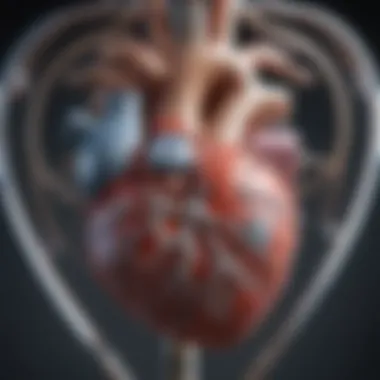Innovations in Heart Mate II: A Breakthrough in Cardiac Care


Intro
The Heart Mate II device is designed to offer crucial support for individuals suffering from end-stage heart failure. As heart conditions progress, the heart's declining ability to pump blood leads to various complications, greatly affecting a patient's quality of life. In such situations, advanced treatment options like the Heart Mate II emerge as pivotal solutions, often providing life-saving support when traditional treatment methods are no longer effective.
This article delves into the multiple facets of the Heart Mate II, examining its engineering innovations, operational mechanisms, and the significant impact it has on clinical outcomes for patients. Furthermore, it discusses how this device has transformed cardiac care and potential implications for the future of mechanical circulatory support.
Article Overview
Purpose of the Article
The primary purpose of this article is to provide a thorough exploration of the Heart Mate II. It aims to inform readers about the critical innovations that define this device, its practical applications in the clinical setting, and the resulting advantages for patients unable to undergo heart transplants. The discussion encompasses both historical developments and current advancements, fostering a deeper understanding of the technology.
Relevance to Multiple Disciplines
The significance of the Heart Mate II extends beyond the realm of cardiac medicine. Understanding its implications is indispensable for various fields, including medical research, nursing, and healthcare policy. By examining this device in detail, we aim to provide insight that can help foster interdisciplinary collaboration and innovation, ultimately advancing the quality of care for patients affected by heart failure.
Research Background
Historical Context
The idea of mechanical circulatory support devices is not new. Over the years, numerous technologies have been developed, evolving significantly with time. The journey began with simpler devices aimed at temporary support. As our understanding of heart diseases improved, so too did the engineering of these devices, culminating in advanced systems like the Heart Mate II, which was introduced in the early 2000s. Its design reflects extensive research and testing, demonstrating substantial improvements over earlier models.
Key Concepts and Definitions
Heart Mate II operates as a left ventricular assist device (LVAD). This type of device assists the heart’s pumping function by taking over a portion of the workload. Here are several key terms that are essential to understanding the Heart Mate II and its functionality:
- Left Ventricular Assist Device (LVAD): A mechanical pump that supports heart function and blood flow in individuals with weakened hearts.
- End-stage Heart Failure: A severe condition where the heart can no longer pump sufficient blood to meet the body's needs.
- Mechanical Circulatory Support: A range of therapeutic devices designed to support or replace heart function in patients with heart failure.
"The Heart Mate II device signifies a leap in technology for patients facing grave heart conditions. Its ability to enhance life quality and prolong survival cannot be overstated."
"The Heart Mate II device signifies a leap in technology for patients facing grave heart conditions. Its ability to enhance life quality and prolong survival cannot be overstated."
Through thorough analysis and insight, this article sets to elucidate the transformative nature of the Heart Mate II within the context of modern cardiac care.
Foreword to the Heart Mate
The Heart Mate II represents a pivotal development in mechanical circulatory support, particularly for patients suffering from end-stage heart failure. Understanding this device is crucial as it embodies not only technological advances but also the evolution of cardiac care methodologies. Its role extends beyond mere functionality and delves into improving patient outcomes and quality of life. This introduction emphasizes the intricate design elements and operational advantages, as well as the considerations for clinicians and caregivers.
Historical Context of Mechanical Circulatory Support
The progression of mechanical circulatory support systems can be traced back to the mid-twentieth century when the first heart-lung machines facilitated complex cardiac surgeries. These early innovations aimed to bridge the gap in cardiac function, but their bulky nature limited application in routine patient care. Over the decades, devices evolved significantly. Noteworthy milestones include the development of external pacers and rudimentary ventricular assist devices.
The advancements in engineering and materials science during the 1980s led to the introduction of more compact and efficient devices. As the need for heart transplantation outpaced organ availability, the focus shifted to improving support systems like the Heart Mate series. Such context is necessary for grasping the significance of modern mechanical devices that state-of-the-art solutions like the Heart Mate II provide.
Emergence of the Heart Mate Series
The Heart Mate series debuted as a response to an urgent clinical need for effective treatment options for patients awaiting heart transplants. The initiative drew upon the findings of early clinical trials that demonstrated improved patient survival rates with mechanical support. Initially, the Heart Mate I was intended for temporary use, but its success laid the groundwork for the Heart Mate II, which incorporated refinements that rendered it suitable for long-term therapy.
The Heart Mate II, approved by the FDA in 2008, featured advanced technology, streamlined design, and a smaller profile, making it easier to implant while ensuring that patients could maintain a level of mobility. This development marked a significant turn in treating heart failure, as it satisfied both short-term and long-term needs efficiently.
With each iteration, the Heart Mate series demonstrated a commitment to enhancing patient care and quality of life. By leveraging cross-disciplinary insights from engineering, medicine, and patient feedback, the Heart Mate II exemplifies how innovation can transform cardiac care.
Design Features of the Heart Mate
The design features of the Heart Mate II are central to its function as a mechanical circulatory support system. Its engineering emphasizes the need for effective and reliable performance, which is crucial for patients experiencing end-stage heart failure. Understanding these features helps stakeholders—including researchers, healthcare professionals, and patients—appreciate the rigorous considerations that have gone into creating this device. Each component is carefully designed to enhance performance, ensure patient safety, and improve quality of life.


Components and Materials Used
The Heart Mate II consists of several primary components, which include a pump, a controller, and a power source. The pump is made from biocompatible materials that reduce the risk of thrombosis and other complications. Common materials include titanium and polyurethane, chosen for their strength and compatibility with bodily tissues.
- Pump: The pump uses an implantable, continuous-flow design. Its rotary blood pump mechanism helps in moving blood efficiently.
- Controller: This element is user-friendly and allows for easy monitoring. It helps track the device’s performance, ensuring functionality.
- Power Source: The device operates on batteries, which can either be recharged or replaced, ensuring patients have the means to support their cardiac function while remaining active.
The selection of materials and components is critical. Biocompatibility minimizes the likelihood of adverse reactions. Such design choices enhance durability and performance, catering specifically to the needs of patients who depend on this innovative solution.
Pump Mechanism and Flow Dynamics
The pump mechanism of the Heart Mate II utilizes rotary blood flow dynamics to facilitate efficient circulation. Unlike traditional pulsatile pumps, this continuous-flow design provides a steady blood flow to the body, reducing the wear and tear on cardiac muscle. This characteristic is important because it mimics the heart’s natural way of functioning.
The anatomy of the pump consists of:
- A rotor that creates suction, drawing blood into the pump.
- A housing that directs the blood flow, allowing for optimal circulation to vital organs.
The efficiency of this mechanism plays a significant role in increasing the circulation, improving patient outcomes. Patients often report fewer symptoms of heart failure, contributing positively to their overall wellbeing. Understanding these dynamics also informs clinical practices and prognoses for patients receiving this type of support.
Durability and Longevity of the Device
Durability is a key consideration when evaluating the Heart Mate II, as it can significantly affect patient quality of life and longevity post-implantation. The design process carefully considered the stresses the device would encounter.
Factors contributing to the device's longevity include:
- Durable materials that withstand mechanical fatigue.
- Engineering that minimizes the risk of device failure.
Research indicates that the device can function effectively for several years, provided it is maintained and monitored appropriately. Regular follow-ups and assessments are essential to address any complications that may arise. The anticipated durability gives hope to patients and healthcare providers, as it facilitates discussions about long-term management and expectations.
In summary, the design features of the Heart Mate II are paramount in establishing an effective solution for patients with severe heart failure. The careful selection of materials, efficient pump mechanisms, and emphasis on durability embody the advances made in mechanical circulatory support. As the field evolves, these innovations may serve as benchmarks for future designs, continually improving cardiac care.
Clinical Application
The clinical application of the Heart Mate II is essential in understanding its role in managing patients with end-stage heart failure. This device serves not only as a bridge to transplantation for some patients but also as a destination therapy for those who are not candidates for surgery. It helps prolong life and improve quality of life for individuals facing severe cardiac limitations. Proper patient selection plays a critical role in optimizing outcomes, and the surgical procedure requires careful planning to ensure successful implantation. Additionally, post-implantation management is vital for monitoring device function and addressing complications.
Patient Selection Criteria
Selecting the right patient for Heart Mate II implantation is crucial. Candidates typically must have a diagnosis of end-stage heart failure, determined to be refractory to medical treatment. Objectives include:
- Age Consideration: Patients might range from 18 to 75 years old, though older individuals may qualify if they meet health standards.
- NYHA Classification: Patients often fall into Class IV, indicating severe limitations and symptoms at rest.
- Comorbidity Assessment: Presence of conditions such as renal dysfunction, pulmonary hypertension, or diabetes can affect candidacy.
- Psychosocial Evaluation: Assessing support systems and the psychological state of the patient is essential.
Careful evaluation based on these factors provides a framework for determining who is most likely to benefit from this advanced therapy.
Surgical Procedure for Implantation
The implantation of the Heart Mate II requires a highly skilled surgical team. A traditional sternotomy is the preferred approach. Here are the important steps:
- Anesthesia Administration: General anesthesia is administered to ensure patient comfort and safety.
- Accessing the Heart: Surgeons make an incision down the chest to expose the heart and surrounding structures.
- Device Placement: The left ventricular assist device is secured to the apex of the left ventricle. A cannula is positioned, directing blood to the aorta.
- Connecting Power Source: The Heart Mate II must connect to an external power source for operation, which is normally located outside the body.
- Monitoring and Closing: Following the successful placement, vital signs and device functionality are closely monitored before closing the chest.
These steps underscore the complexity of the procedure, emphasizing the need for specialized experience.
Management Post-Implantation
Effective management after implantation is critical to the sustainability of patient outcomes. Key components include:
- Regular Monitoring: Continuous monitoring for device function, blood flow rates, and any signs of complications is essential.
- Medication Compliance: Patients need to adhere to anticoagulation therapies to prevent thrombus formation.
- Routine Follow-Up: Scheduled follow-ups with healthcare providers ensure that any abnormalities are detected early.
- Lifestyle Adjustments: Education on lifestyle changes, including dietary restrictions and physical activity guidelines, enhances overall health.


The importance of this management cannot be overstated, as it impacts longevity and quality of life.
"Transitioning to a Heart Mate II is not just a mechanical change; it also requires a shift in patient mindset and habits."
"Transitioning to a Heart Mate II is not just a mechanical change; it also requires a shift in patient mindset and habits."
In summary, the clinical application of the Heart Mate II involves meticulous attention to patient selection, an intricate surgical procedure, and an ongoing commitment to post-operative management. Each element plays a vital role in ensuring the device's success as a life-supporting solution for those with severe heart failure.
Outcomes and Efficacy
The discussion surrounding the outcomes and efficacy of the Heart Mate II is critical for understanding its overall impact on patients with end-stage heart failure. Evaluating success metrics, durability, and quality of life comes to the forefront of clinical considerations. These metrics help determine the effectiveness of this device in enhancing patient health and longevity. Moreover, they allow healthcare professionals to make informed decisions regarding treatment options.
Survival Rates and Longevity
Survival rates have been a focal point in examining the efficacy of the Heart Mate II. Clinical trials indicate that the device significantly increases overall survival for selected patients. Studies highlight that patients receiving the Heart Mate II experience a median survival of approximately 27 months, which is a substantial improvement compared to historical controls without mechanical support. Extended follow-ups have shown that about 45% of patients remain alive five years post-implantation.
Factors that affect longevity include:
- Patient Selection: Proper screening and selection criteria are essential in optimizing outcomes.
- Post-operative Care: Comprehensive follow-up strategies enhance device longevity through effective management of potential complications.
- Adherence to Protocols: Patients following prescribed medical regimens demonstrate improved survival rates.
"The Heart Mate II not only extends survival but also provides a mechanism to manage symptoms of heart failure effectively."
"The Heart Mate II not only extends survival but also provides a mechanism to manage symptoms of heart failure effectively."
These outcomes signify a paradigm shift in managing severe heart conditions, providing hope for patients who otherwise have limited options.
Patient Quality of Life Assessments
Evaluating quality of life post-implantation is another essential aspect. Many studies indicate substantial improvements in quality of life for patients using the Heart Mate II. Patients report enhanced physical activity, reduced symptoms, and overall better satisfaction with healthcare services.
Key components of quality of life assessments include:
- Functional Status: Patients typically experience improved exercise tolerance and stamina, contributing to daily activities.
- Psychological Well-being: Many patients note a decrease in anxiety and depression levels, as living with improved heart function brings a sense of relief.
- Social Interaction: The ability to engage in social activities increases, which is vital for mental health.
Factors influencing these assessments often stem from the model of support provided by mechanical circulatory systems, as they aim to minimize hospitalizations and enhance patient independence.
Long-Term Complications Associated with Use
Although the Heart Mate II has demonstrated many benefits, it is essential to acknowledge the long-term complications associated with its use. As with any medical device, potential complications can arise. Commonly reported issues include:
- Thromboembolic Events: Blood clots are a significant concern, requiring close monitoring and anticoagulation strategies.
- Infections: Device-associated infections can occur, particularly at the driveline site, necessitating vigilance in postoperative care.
- Device Malfunction: Although infrequent, mechanical failures can happen, leading to a risk of severe complications.
Awareness and proactive management of these complications are crucial for ensuring patient safety and maintaining the overall efficacy of the Heart Mate II. Professionals must balance the benefits of survival and quality of life improvements against the potential risks they present.
Technological Advancements
Technological advancements play a crucial role in enhancing the efficacy and usability of the Heart Mate II device. The ongoing improvements not only focus on the core functions of hemodynamic support, but also on integrating additional technologies that benefit both patients and clinicians. Key elements include design innovations and remote monitoring capabilities, which have a direct impact on patient care. Understanding these advancements facilitates a deeper appreciation of how technology shapes modern cardiac support systems.
Improvements in Design Over Time
The design of the Heart Mate II has evolved to address many challenges faced by earlier mechanical circulatory support devices. Innovations in the pump mechanism have improved its efficiency. The Heart Mate II utilizes a continuous-flow technology, which reduces the risks of thrombus formation. This design change results in a device that is less likely to cause complications, such as pump thrombosis.
Moreover, the materials used have been refined to enhance biocompatibility. Biocompatible materials reduce the risk of inflammation and other adverse reactions in the body. The external housing is lighter, making the device easier for patients to carry. These design improvements have been instrumental in increasing the overall comfort and functionality of the Heart Mate II.
"The evolution of the Heart Mate II underscores the significance of continuous research and adaptation in medical device design, ultimately improving patient outcomes."


"The evolution of the Heart Mate II underscores the significance of continuous research and adaptation in medical device design, ultimately improving patient outcomes."
Integration with Remote Monitoring Systems
The integration of remote monitoring systems represents a significant leap forward in managing patients with the Heart Mate II. These systems enable healthcare providers to track patient parameters in real-time, facilitating timely interventions when needed. Health care professionals can monitor vital metrics such as flow rates and battery levels from afar, which enhances safety.
The advantages of this integration include:
- Proactive Management: Clinicians can act swiftly if they detect any abnormalities.
- Patient Engagement: Patients gain access to their health data, increasing awareness and adherence to treatment.
- Reduced Hospital Visits: Remote monitoring decreases the frequency of in-person check-ups, which can be a burden for patients.
In summary, the advancements in technology associated with the Heart Mate II device reflect a broader trend in healthcare toward personalization and enhanced patient support. As technology progresses, so does the potential for improving the lives of individuals with heart failure.
Future Perspectives
The future of mechanical circulatory support, particularly with devices like the Heart Mate II, is a topic of critical significance. Understanding where innovations might lead encompasses multiple dimensions: technological advancements, clinical applications, and how these devices integrate into overall cardiac care. This exploration is essential for patients who may not be eligible for transplantation, highlighting the continued relevance of such devices in extending and enhancing life.
Research Directions and Innovations
Research in the area of mechanical circulatory support is gaining momentum. Ongoing studies aim to explore novel materials and designs that can enhance the performance of devices like the Heart Mate II. The potential for bioengineered tissues, for example, could revolutionize the way these implants work, making them more compatible with the human body.
Key areas of research include:
- Improved blood compatibility to minimize the risk of thrombosis.
- Innovations in engine technology to reduce power consumption.
- Development of more compact and less invasive designs.
A focus on miniaturization may also pave the way for smaller devices, which could expand the range of patients who can benefit from circulatory support. These innovations also carry the promise of better patient outcomes and improved quality of life.
Potential for Total Artificial Heart Systems
When examining the future, it is vital to consider the evolvement towards total artificial heart systems. The Heart Mate II represents a significant step in this direction. As technology evolves, the prospect of creating a fully functional artificial heart becomes increasingly feasible.
Potential benefits include:
- Providing a solution for patients with severe heart failure who are not candidates for transplantation.
- Reducing dependency on donor hearts and long waiting lists.
- Enhanced patient mobility and quality of life through advanced functionality.
The integration of artificial intelligence with these systems can allow for real-time monitoring and adjustments that adapt to the patient’s unique physiology. Therefore, looking ahead to total artificial hearts not only meets the medical need but also aligns with a broader trend toward personalized medicine.
"The future of heart support systems lies in innovation that enhances both function and patient experience."
"The future of heart support systems lies in innovation that enhances both function and patient experience."
In summary, the prospects for the Heart Mate II and similar devices are promising. They reflect evolving research directions and the potential for significant advancements in total artificial hearts. This ongoing discourse is crucial for enhaancing outcomes and expanding the options available for patients suffering from heart failure.
Epilogue
The conclusion serves as a vital component of this article, synthesizing the discussed aspects of the Heart Mate II. This mechanical circulatory support device has reshaped cardiac care, giving new hope to patients experiencing end-stage heart failure. Summarizing key findings, we can underscore the effectiveness, technological advancements, and clinical outcomes associated with the Heart Mate II.
Summarizing Key Findings
The Heart Mate II presents several notable insights into the realm of cardiac care. Firstly, its design and functionality allow for improved blood flow dynamics, decreasing the workload on the heart. Clinical studies have shown that patients using the Heart Mate II experience increased survival rates, especially when traditional heart treatments have failed. The device has become a benchmark in the field, influencing future innovations in mechanical support systems.
Moreover, long-term patient management following implantation has demonstrated that many individuals can maintain a better quality of life. Potential complications have been identified, but with careful management, the benefits often outweigh the risks. Further, the integration of telemonitoring systems enhances patient oversight, leading to prompt intervention when necessary.
The Role of Heart Mate in Cardiac Care
Heart Mate II plays a crucial role in modern cardiac therapies. For patients who do not qualify for heart transplants, this device can be a bridge to recovery or a long-term solution to manage heart failure. Its significance extends beyond survival. The Heart Mate II supports patients in improving their daily activities, ranging from simple tasks to more strenuous endeavors.
In further consideration, the Heart Mate II exemplifies innovation in medicine. As technology progresses, we expect more enhancements that could lead to greater efficacy in treating heart-related diseases. The focus will likely shift towards integrating artificial intelligence in monitoring and managing patient care, making devices like Heart Mate II even more effective.
"The Heart Mate II demonstrates the remarkable potential of engineering solutions to address critical health challenges, marking a new era in cardiac support."
"The Heart Mate II demonstrates the remarkable potential of engineering solutions to address critical health challenges, marking a new era in cardiac support."
Through these insights, the future of mechanical circulatory support appears promising. Ongoing research and clinical evaluations will continue to detail the device's impact on patient populations, ultimately resulting in more refined treatment strategies.



